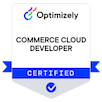Every once in a while a client mentions the request for their global website to have country specific content based on a country segment in the URL. Resulting in specific URLs like domain.com/nl/nl/ for Dutch content in Dutch, and domain.com/be/nl/ for Belgian content in Dutch.
Most times we talk the client into using the region parts in cultures. So use the en neutral culture for global English, the culture nl-NL for Dutch content in Dutch and the nl-BE culture for Belgian content in Dutch. However sometimes, using this approach we run into problems when a culture does not exist. Say we want the Dutch content to be available in German too, the de-NL culture does not exist.
This got me thinking about adding an URL segment to the URL for a specific country, where the country is represented by an episerver visitor group.
With the help of this blog explaining custom routing for Episerver I created my custom segment and a custom visitor group.
public class VisitorGroupSegment : SegmentBase
{
public VisitorGroupSegment(string name) : base(name)
{
}
public override bool RouteDataMatch(SegmentContext context)
{
SegmentPair nextValue = context.GetNextValue(context.RemainingPath);
// For the first fragment, check if it is a 'visitor group' segment
if (context.LastConsumedFragment is null && IsVisitorGroupSegment(nextValue.Next))
{
context.RemainingPath = nextValue.Remaining;
// Data Token to be used by VisitorGroup Criterion
context.RouteData.DataTokens.Add("visitorgroup", nextValue.Next);
return true;
}
return false;
}
private static bool IsVisitorGroupSegment(string segment)
{
var visitorGroupRepository = ServiceLocator.Current.GetInstance<IVisitorGroupRepository>();
foreach (var vg in visitorGroupRepository.List())
{
foreach (var criterion in vg.Criteria)
{
if (criterion.Model is RouteVisitorGroupSettings model &&
model.RouteSegment.Equals(segment, StringComparison.InvariantCultureIgnoreCase))
{
return true;
}
}
}
return false;
}
public override string GetVirtualPathSegment(RequestContext requestContext, RouteValueDictionary values)
{
if (GetContextMode(requestContext.HttpContext, requestContext.RouteData)
!= ContextMode.Default)
{
return null;
}
return GetRoutingVisitorGroupByCurrentUser(new HttpContextWrapper(HttpContext.Current));
}
private static ContextMode GetContextMode(HttpContextBase httpContext, RouteData routeData)
{
var contextModeKey = "contextmode";
if (routeData.DataTokens.ContainsKey(contextModeKey))
{
return (ContextMode)routeData.DataTokens[contextModeKey];
}
if (httpContext?.Request == null)
{
return ContextMode.Default;
}
if (!PageEditing.PageIsInEditMode)
{
return ContextMode.Default;
}
return ContextMode.Edit;
}
private static string GetRoutingVisitorGroupByCurrentUser(HttpContextBase httpContext)
{
var visitorGroupRepository = ServiceLocator.Current.GetInstance<IVisitorGroupRepository>();
var visitorGroupRoleRepository = ServiceLocator.Current.GetInstance<IVisitorGroupRoleRepository>();
var user = httpContext.User;
// Check all visitor groups and check if one is active, if one is active return the segment.
var visitorGroups = visitorGroupRepository.List();
foreach (var vg in visitorGroups)
{
foreach (var criterion in vg.Criteria)
{
if (criterion.Model is RouteVisitorGroupSettings model && visitorGroupRoleRepository.TryGetRole(vg.Name, out var virtualRoleObject))
{
if (virtualRoleObject.IsMatch(user, httpContext))
{
return model.RouteSegment;
}
}
}
}
return null;
}
}
The custom visitor group:
public class RouteVisitorGroupSettings : CriterionModelBase
{
[Required]
public string RouteSegment { get; set; }
public override ICriterionModel Copy()
{
return ShallowCopy();
}
}
[VisitorGroupCriterion(
Category = "Technical",
DisplayName = "VisitorGroup Routing",
Description = "")]
public class RouteVisitorGroupCriterion : CriterionBase
{
public override bool IsMatch(IPrincipal principal, HttpContextBase httpContext)
{
// Check for DataToken added by RouteSegment.
var routeDataTokens = httpContext.Request.RequestContext.RouteData.DataTokens;
return routeDataTokens.ContainsKey("visitorgroup")
&& ((string)routeDataTokens["visitorgroup"]).Equals(Model.RouteSegment, StringComparison.InvariantCultureIgnoreCase);
}
}
Use an initializable module to make this work:
[InitializableModule]
[ModuleDependency(typeof(EPiServer.Web.InitializationModule))]
public class RouteEventInitializationModule : IInitializableModule
{
public void Initialize(InitializationEngine context)
{
var segment = new VisitorGroupSegment("visitorgroup");
var routingParameters = new MapContentRouteParameters()
{
SegmentMappings = new Dictionary<string, ISegment>()
};
routingParameters.SegmentMappings.Add("visitorgroup", segment);
RouteTable.Routes.MapContentRoute(
name: "visitorgroups",
url: "{visitorgroup}/{language}/{node}/{partial}/{action}",
defaults: new { action = "index" },
parameters: routingParameters);
}
public void Uninitialize(InitializationEngine context)
{
}
}
Now by adding this to a default Alloy site and creating two vistorgroups, one with segment ‘nl’ for Netherlands called 'NLD', and one with segment ‘en’ for United Kingdom called 'ENG'. I can display different content using personalization by visitor groups.

| http://localhost:23529/ | http://localhost:23529/en http://localhost:23529/en/en |
http://localhost:23529/nl http://localhost:23529/nl/en |
 |
 |
 |
This is just a simple proof of concept, all seems to be working correctly, but I would not copy paste this into a production environment.



